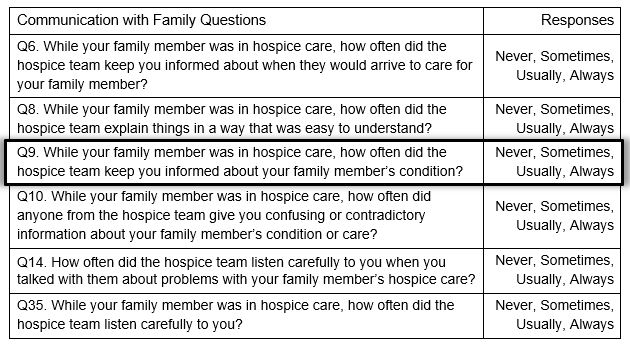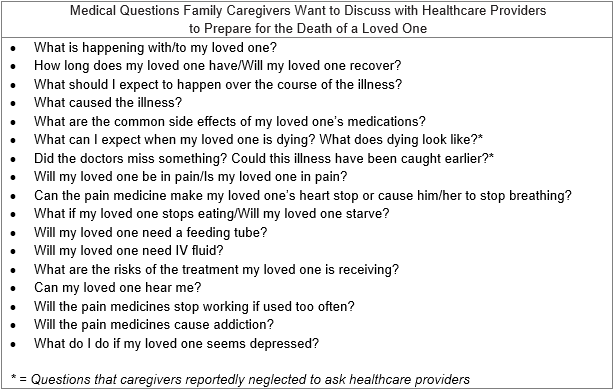
The Consumer Assessment of Healthcare Providers and Systems (CAHPS) Hospice Survey empowers hospice organizations by attracting referral sources, driving business growth, and sustaining compliance with industry regulations, including the current pay-for-reporting requirements and the shift to value-based care on the industry’s horizon. By evaluating hospice patient and caregiver experiences, the CAHPS Hospice Survey delivers valuable insights to hospice organizations and contributes to ongoing efforts to improve patient and family experiences. Understanding the impact of the CAHPS Hospice Survey and how to improve ratings is essential to hospices’ long-term growth and sustainability.
Question 9 – Discussing the Patient’s Condition
Question 9 is one of six questions comprising the Communication with Family domain, designed to assess the hospice team’s communication proficiency.

This question evaluates the caregiver’s perception of how frequently the hospice interdisciplinary team communicated information about the patient’s condition. Optimizing performance on this question relies on the abilities of hospice providers to sustain communicative partnerships with care recipients, in which information about the patient’s condition is communicated clearly and thoroughly.
Tips to Improve Communication with Patients and Families
- Orient family members to the patient’s condition at the start of care and review key information continuously throughout care.
- When first discussing the patient’s condition, find out what family caregivers already know and what they want to know about the patient’s illness to fill in disparities in their knowledge.
- Coordinate with all other members of the interdisciplinary team to ensure communication on the patient’s illness is interconnected and consistent.
- Employ teaching aids to supplement verbal communication and promote retention of key information.
- When discussing a hospice patient’s condition with family caregivers, avoid medical jargon, confirm comprehension using teach-back techniques, and repeat key points using different approaches until understanding is confirmed.
- Ask for and encourage questions reiteratively.
Discussing the hospice patient’s condition is an indispensable component of preparing informal caregivers to successfully manage their roles in hospice care. Hospice organizations should maintain structured procedures for delivering prognosis information to family members and continuously nurturing their understanding of the patient’s illness.
Tools for Educating Family Members on the Patient’s Condition
Providing a handbook on admission to hospice care is a common practice among hospice organizations, and a seamless opportunity to integrate prognosis training. Family Caregiver Alliance (FCA) provides fact sheets in multiple languages with information on dementia, stroke and other conditions that commonly impact hospice patients. These fact sheets are examples of disease-specific resources that agencies can integrate in hospice admission materials for informal caregivers to reference and review regularly with the hospice interdisciplinary team.
What Family Members of Hospice Patients Want to Know
A study published in the Journal of Palliative Medicine analyzed questions that family caregivers believe are important to discuss with healthcare providers in preparation for the death of a loved one. Caregivers’ questions were categorized under medical, practical, psychosocial and spiritual dimensions. Medical questions are listed in descending order below.
Echoing shared findings of related research, the study mentions that many family members report never receiving information about life expectancy or the incurable nature of the patient’s condition. Family caregivers may not always ask questions, so understanding questions that many caregivers want answered is important for hospice providers to ensure ample information on the patient’s condition is communicated.

These questions are not inclusive of or relevant to all family caregivers, so care communication must always be individualized based on the specific goals and values of the care recipients. As stated in the article, “the only way for [healthcare providers] to know which questions are relevant or important to a particular caregiver is to ask.” Maintain a comfortable and collaborative environment in which patients and their family members communicate openly with members of the interdisciplinary team to cultivate and sustain a thorough understanding of the patient’s condition.
Check our blogs for the series on improving CAHPS Hospice Survey scores by systematically reviewing each survey question and exploring opportunities for improvement. Our next installment will continue the discussion on optimizing communication between hospice care providers and recipients to improve the quality of patient and family lives.
